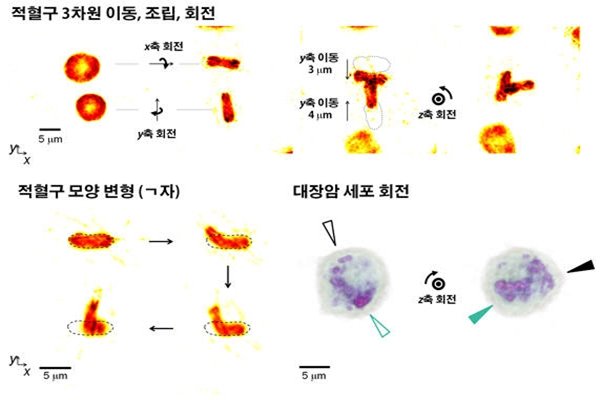Korea Advanced Institute of Science & Technology (KAIST, Chancellor Shin Sung-chul) has succeeded in moving and changing cells by improving ‘optical tweezers’ technology that moves substances by using light. It is expected that this technology will be widely used for researching cells and manufacturing and assembling small substances.
KAIST announced on the 25th that a research team led by Professor Park Yong-keun of Physics Department has developed holography optical forceps technology that can freely control complicated small 3D substances by using laser beam.
Optical tweezers technology is a technology that moves small substance by making an optical focal point with laser and it uses ‘photon energy’ which is the pressure of photon. Changing quantity of motion by bending light that is inside of a substance and moving a substance by moving optical focal point are its principles.
However substances with complicated inner structures could not be moved until now because it was difficult to calculate pressure that is exerted by light on a substance and control of direction of movement was also limited.

Research team has increased ability of controlling a substance by optical tweezers by using a method where substances and shapes shoot same 3D laser beam and it used holographic microscope in setting up shape of light. It predicted 3D images of substances by using ‘optical diffraction tomography’, which is similar to CT (Computer Tomography). 3D laser beam that is made based on this method can move substances with complicated inner structures. Principle of this beam makes movement easier as amount of area where light inside of a substance touches 3D laser beam has increased.
Through tests, research team found out that performance of optical tweezers is maximized when shapes of light and substance are same. It is possible to control substances with complicated structures like cells.
Research team already succeeded in rotating and changing red blood cells and it is possible to make a new structure by combining two red blood cells. It also succeeded in rotating colon cancer cells with sizes between 10 and 20 micrometers at a desirable angle.
Research team explained that this technology can be widely used in biological fields such as analyzing cells in detail and carrying out surgeries on cells. New applied technologies can also be developed by using this technology to manufacture and assemble small substances.
“We have developed a technology that can freely move and change small substances with very complicated structures.” said Professor Park Yong-keun. “We can now add more details and preciseness to variety of scientific technologies.”
Staff Reporter Kim, Youngjoon | kyj85@etnews.com